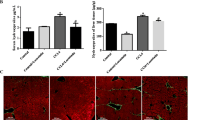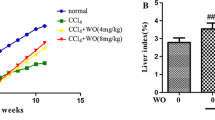Abstract
The aim of this study was to investigate the effect of gallic acid (GA) on liver fibrosis induced by carbon tetrachloride (CCl4). Male BALB/c mice were randomly divided into four groups: normal control group (group A), CCl4-induced liver injury control group (group B), and CCl4 induction with GA of low dose (5 mg/kg) and high dose (15 mg/kg) treatment group (group C and group D). GA was intra-gastric given for mice once a day after 2 weeks of CCl4 induction. Animals were killed at the eighth week. Degrees of fibrosis and collagen percentage were measured. Hyaluronic acid (HA), type IV collagen (cIV), malondialdehyde (MDA), alanine aminotransferase (ALT), aspartate aminotransferase (AST), and gamma-glutamyl transferase (γ-GT) were determined. Expression of matrix metalloproteinases-2 (MMP-2) and tissue inhibitor of matrix metalloproteinases-1 (TIMP-1) mRNA levels were examined by RT-PCR. Western blotting was carried out to evaluate the changes of MMP-2 protein. HE and VG stainings showed GA in a dose-dependent manner improved significantly the fibrosis condition in CCl4-injured mice (P < 0.05 or P < 0.01). Also, the concentrations of HA, cIV, and MDA, as well as the serum levels of ALT, AST, and γ-GT were markedly reduced by GA (P < 0.05 or P < 0.01), and decreases in MMP-2, TIMP-1 mRNA, and MMP-2 protein were observed as well (P < 0.05 or P < 0.01). GA could exert protective effect on liver injury and reduce liver fibrosis induced by CCl4 in mice, which might be through the inhibition of hepatic stellate cell activity.



Similar content being viewed by others
References
Lin, K. W., Kirchner, J. T., & Hepatitis, B. (2004). American Family Physician, 69, 75–82.
Lai, C. L., Ratziu, V., Yuen, M. F., & Poynard, T. (2003). Viral hepatitis B. Lancet, 362, 2089–2094.
Poynard, T., Yuen, M. F., Ratziu, V., & Lai, C. L. (2003). Viral hepatitis C. Lancet, 362, 2095–2100.
McClain, C. J., Song, Z., Barve, S. S., Hill, D. B., & Deaciuc, I. (2004). Recent advances in alcoholic liver disease. IV. Dysregulated cytokine metabolism in alcoholic liver disease. American Journal of Physiology. Gastrointestinal and Liver Physiology, 287, G497–G502.
Levy, M. T., Trojanowska, M., Reuben, A., & Oncostatin, M. (2000). A cytokine.upregulated in human cirrhosis, increases collagen production by human hepatic stellate cells. Journal of Hepatology, 32, 218–226.
Kroes, B. H., van den Berg, A. J., van Quarles, U. H. C., et al. (1992). Anti-inflammatory activity of gallic acid. Planta Medica, 58(6), 499–504.
Abdelwahed, A., Bouhlel, I., Skandrani, I., et al. (2007). Study of antimutagenic and antioxidant activities of Gallic acid and 1,2,3,4,6-pentagalloylglucose fromPistacia lentiscus.Confirmation by microarray expression profiling. Chemico-Biological Interactions, 165(1), 1–13.
Faried, A., Kurnia, D., Faried, L. S., et al. (2007). Anticancer effects of gallic acid isolated from Indonesian herbal medicine, Phaleria macrocarpa (Scheff.) Boerl, on human cancer cell lines. International Journal of Oncology, 30(3), 605–613.
Kim, Y. J. (2007). Antimelanogenic and antioxidant properties of gallic acid. Biological and Pharmaceutical Bulletin, 30(6), 1052–1055.
Chen, H. M., Wu, Y. C., Chia, Y. C., et al. (2009). Gallic acid, a major component of Toona sinensis leaf extracts, contains a ROS mediated anti-cancer activity in human prostate cancer cells. Cancer Letters, 286(2), 161–171.
Sakaguchi, N., Inoue, M., & Ogihara, Y. (1998). Reactive oxygen species and intracellular Ca2 +, common signals for apoptosis induced by gallic acid. Biochemical Pharmacology, 55(12), 1973–1981.
Imamura, M., Ogawa, T., Sasaguri, Y., Chayama, K., & Ueno, H. (2005). Suppression of macrophage infiltration inhibits activation of hepatic stellate cells and liver fibrogenesis in rats. Gastroenterology, 128(1), 138–146.
Cheng, M. L., & Yang, C. Q. (2002). Progress in the researches of pathogenetic mechanism in liver fibrosis (2nd ed.). Beijing: People’s Medical Publishing House.
Kovalovich, K., Angelis, R. D., Li, W., Furch, E., Cliberto, G., & Taub, R. (2000). Increased toxin-induced liver injury and fibrosis in IL-6 deficient mice. Hepatology, 31, 149–159.
Cheung, P. Y., Zhang, Q., Zhang, Y. O., Bai, G. R., Chia, M., & Lin, M. (2006). Effect of WeiJia on carbon tetrachloride induced chronic liver injury. World Journal of Gastroenterology, 12(12), 1912–1917.
Huang, S. S., Yeh, S. F., & Hong, C. Y. (1995). Effects of anthraquinone derivatives on lipid perxoidation in rat heart mitochondria:structure activity relationship. Journal of Natural Products, 58, 1365–1371.
Nieto, N., Friedman, S. L., & Cederbaum, A. I. (2002). Cytochrome P450 2E1-derived reactive oxygen species mediate paracrine stimulation of collagen I protein synthesis by hepatic stellate cells. The Journal of Biological Chemistry, 277(12), 9853–9864.
Preaux, A. M., Mallat, A., Nhieu, J. T. V., D’Ortho, M. P., Hembry, R. M., & Mavier, P. (1999). Matrix metalloproteinase-2 activation in human hepatic fibrosis regulation by cell–matrix interactions. Hepatology, 30, 944–950.
Meena, B., Kellen, K., Ritu, G., Wei, L., & Akansha, A. (2005). Interleukin-6 protects hepotocyte from CCl4-mediated necrosis and apoptosis in mice by reducing MMP-2 expression. Journal of Hepatology, 42, 548–556.
Liu, H. L., Li, H. X., Wang, Y. D., & Yang, S. P. (2000). Matrix metalloproteinase-2 and tissue inhibitor of metalloproteinase-1 expression in fibrotic rat liver. World Journal of Gastroenterology, 6(6), 881–884.
Leroy, V., Monier, F., Bottari, S., Trocme, C., Sturm, N., Hilleret, M. N., et al. (2004). Circulating matrix metalloproteinases 1, 2, 9 and their inhibitors TIMP-1 and TIMP-2 as serum markers of liver fibrosis in patients with chronic hepatitis C: Comparison with PIIINP and hyaluronic acid. American Journal of Gastroenterology, 99(2), 271–279.
Shiba, M., Shimizu, I., Yasuda, M., Ii, K., & Ito, S. (1998). Expression of type Iand type III collagens during the course of dimethylnitrosa mine induced hepatic fibrosis in rats. Liver, 18, 196–204.
Iredale, J. P., Benyon, R. C., Arthur, M. J. P., Ferris, W. F., Alcolado, R., Winwood, P. J., et al. (1996). Tissue inhibitor of metalloproteinases-1 messenger RNA expression is enhanced relative to interstitial collagenase messenger RNA in experimental liver injury and fibrosis. Hepatology, 24, 176–184.
Acknowledgments
This work was supported by the project of International Cooperation in Science and Technology (No. 2013KW-27-01), the Fundamental Research Funds for the Central Universities (No. 2012jdhz43), and the National Natural Science Foundation (No. 81350110242).
Author information
Authors and Affiliations
Corresponding author
Rights and permissions
About this article
Cite this article
Wang, J., Tang, L., White, J. et al. Inhibitory Effect of Gallic Acid on CCl4-Mediated Liver Fibrosis in Mice. Cell Biochem Biophys 69, 21–26 (2014). https://doi.org/10.1007/s12013-013-9761-y
Published:
Issue Date:
DOI: https://doi.org/10.1007/s12013-013-9761-y




